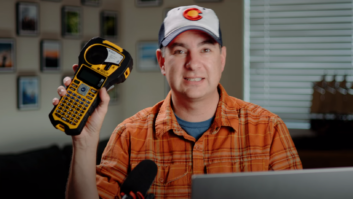This is one in a series of articles on the fundamentals of FM transmission systems.
A broadcast engineer designing an FM transmission system has a number of choices for transmission line size and type.
The factors that enter into this decision are transmitter power, line length and antenna gain. All three factors are somewhat variable.
It is not uncommon for a given ERP and antenna gain to have the transmitter power level determined by the transmission line size and type. Changing to a larger or lower-loss line may permit the use of a smaller transmitter, somewhat offsetting the added cost of the better line. The other side of that coin is that the larger line may require a beefier tower to support it, adding cost to the project.
Usually, however, the choice is more clear.
Starting point
The first step in finding a suitable transmission line for a system is to determine the approximate power the line will have to carry. This is calculated by dividing the effective radiated power (ERP) in kW by the antenna power gain, or by subtracting the antenna gain in dB from the ERP in dBk and converting back to kilowatts.
This calculation will yield the antenna input power, or the transmitter power output less the line loss, which is as yet unknown. While the antenna input power does not represent the total power in the line, it is a good starting point. Keep in mind that in combined systems, the power in the line is the sum of the power of each station.
Next, go to the manufacturer’s catalog and find a line that exceeds the calculated line output power by a good margin, keeping in mind that the input power (which is the maximum power the line will have to carry) will be somewhat higher.
While any of a number of transmission lines may have an adequate power rating, there will be few choices that offer both acceptable performance and economy. A good rule to follow when selecting a transmission line is to use the smallest line possible consistent with the required power handling capability. There are certainly exceptions, such as in the case of a very long transmission line, where it may be more important to keep losses (and thus long-term operating costs) down than the initial investment. As a rule, however, the goal should be to ensure adequate performance while minimizing cost.
With a likely candidate selected, find the loss of the line at the operating frequency and line length. Manufacturers typically provide this information in dB per 100 feet or 100 meters. Divide the line length in feet or meters by 100 and multiply by the per unit loss to get the total line loss in dB.
To find the transmission line input power (or transmitter power output, TPO), add the line loss in dB to the antenna input power in dBk. Convert back to kilowatts by dividing by 10 and taking the antilog. The loss of the line in kilowatts can be determined by subtracting the antenna input power from the transmitter power output. Divide the antenna input power by the TPO and multiply by 100 to calculate the efficiency of the line in percent.
Table 1 shows an example of a system calculation. The system specifies an ERP of 50 kW, a four-bay antenna, and 500 feet of line at 100 MHz.
Rounding in accordance with 47 C.F.R. §73.212, the operating TPO becomes 27.5 kW.
Headroom
The next question becomes one of headroom. Is a 3-inch line with a 42 kW power rating adequate?
To find the answer, we must derate the line for VSWR. To do this, simply divide the power rating of the line by the worst-case VSWR.
A good number to use to account for possible icing of the antenna is 2:1. In our example, the derated average power capability of the line for 2:1 VSWR is 21 kW. Is this reasonable for a 27.5 kW input power?
The answer to that question is determined by estimating the risk of the VSWR ever getting to that point. Are the protective circuits in the transmitter reliable? Are there deicers or radomes on the antenna, and are they effective and reliable? In most cases, you can count on your protective and deicing systems to do the job.
It is not wise, however, to put your eggs all in one basket. An outboard VSWR or reflected power monitoring device is a good investment to protect your expensive transmission line.
The trip point of the device should be set below the level that would exceed the rated average power of the line with full transmitter power output. In our example, the line is rated at 42 kW. Divide that by the TPO of 27.5 kW to find the maximum VSWR that will derate the transmission line to the TPO. In our example, this VSWR is 1.53:1. The idea is to make sure that in the worst case – with the transmitter running at full power into some sort of antenna problem – the line will be protected.
In the next installment, we will deal with transmission line installation, pressurization, maintenance and repairs.



